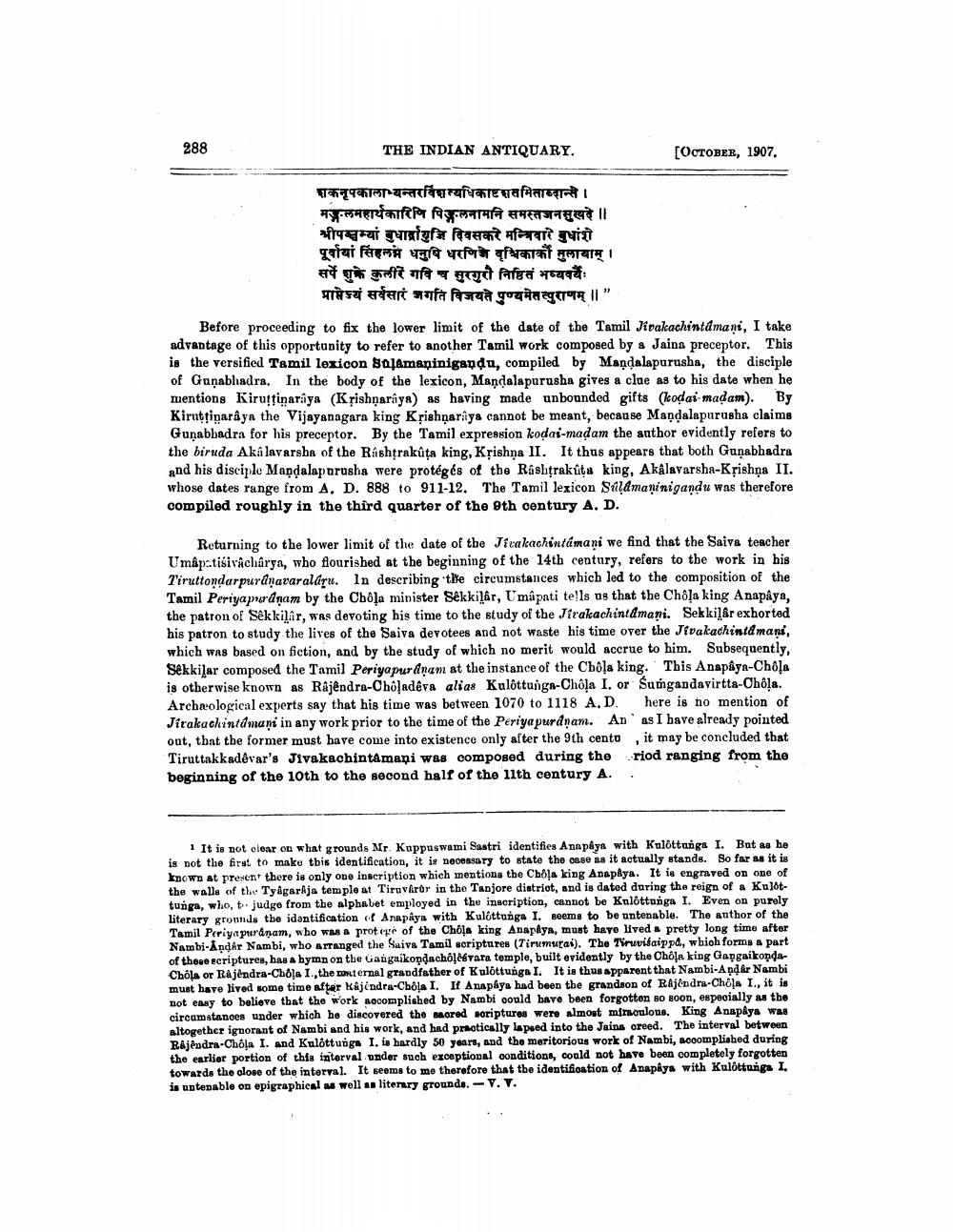________________
288
THE INDIAN ANTIQUARY.
[OCTOBER, 1907,
काकनृपकालाभ्यन्तरविंशत्यधिकाष्टशसमितादान्ते । मजलमहार्थकारिणि पिङ्गलनामनि समस्तजनसुखदे। श्रीपञ्चम्या बुधा युजि दिवसकरे मन्त्रिबारे बुधांशे पूर्वायां सिंहलग्ने धनुषि धरणि वृश्चिकाको मुलायाम् । सर्प शुके कुलीरें गविच सुरगुरौ निष्ठितं भष्यवः प्राज्यं सर्वसारं जगति विजयते पुण्यमेतत्पुराणम् ॥"
Before proceeding to fix the lower limit of the date of the Tamil Jivakachintamani, I take advantage of this opportunity to refer to another Tamil work composed by a Jaina preceptor. This is the versified Tamil lexicon Bajamaninigandu, compiled by Mandalapurusha, the disciple of Guņabhadra. In the body of the lexicon, Mandalapurusha gives a clue as to his date when he mentions Kiruttinaraya (Krishộarîya) as having made unbounded gifts (kodai madam). By Kiruttinaraya the Vijayanagara king Krishnariya cannot be meant, because Mandalapurusha claims Guņabhadra for his preceptor. By the Tamil expression kodai-madam the author evidently refers to the biruda Aka lavarsha of the Rashtrakůta king, Krishna II. It thus appears that both Gunabhadra and his disciple Mandalap urushs were protégés of the Rashtraküta king, Akalavarsha-Kộishņa II. whose dates range from A. D. 888 to 911-12. The Tamil lexicon Saldmaninigandu was therefore compiled roughly in the third quarter of the 9th century A. D.
Returning to the lower limit of the date of the Jivakachintamani we find that the Saiva teacher Umâpatiśivacharya, who flourished at the beginning of the 14th century, refers to the work in his l'iruttondarpurânavaraläru. In describing the circumstances which led to the composition of the Tamil Periyapardņam by the Chola minister Sekkilar, Umâpati tells us that the Chola king Anapaya, the patron of Sekkilar, was devoting his time to the study of the Jirakachintamani. Sekkilar exhorted his patron to study the lives of the Saiva devotees and not waste his time over the Jivakachintamani, which was based on fiction, and by the study of which no merit would accrue to him. Subsequently, Sekkilar composed the Tamil Periyapuranam at the instance of the Chola king. This Anapaya-Chola is otherwise known as Rajendra-Chadeva alias Kulottunga-Chola I. or Sumgandavirtta-Chola. Archæological experts say that his time was between 1070 to 1118 A.D. here is no mention of Jirakachintámani in any work prior to the time of the Periyapurdnam. An as I have already pointed out, that the former must have come into existence only after the 9th cento , it may be concluded that Tiruttakkadôver's Jivakachintamani was composed during the riod ranging from the boginning of the 10th to the second half of the 11th century A..
1 It is not clear on what grounds Mr. Kuppuswami Sastri identifies Anapays with Kulottunga I. But as he is not the first to make this identification, it is necessary to state the 06.30 as it actually stands. So far as it is known at present there is only one inscription which mentions the Chola king Anapaya. It is engraved on one of the walls of the Tyagarkja temple at Tiruvarur in the Tanjore district, and is dated during the reign of a Kuldttunga, who, t. judge from the alphabet employed in the inscription, cannot be Kulottunga I. Even on purely literary gronds the idantification of Anapays with Kulottunga I. seems to be untenable. The author of the Tamil Periya puranam, who was a protege of the Chola king Anapkya, must have lived s pretty long time after Nambi-Åndár Nambi, who arranged the Saiva Tamil scriptures (Tirumurai). The Tiruvitaippa, which forms a part of theue scriptures, has a hymn on the Gangaikopdachôļefvara templo, built ovidently by the Chola king GangaikondaChola or Rajendra-Chola I., the wonternal grandfather of Kalóttunga I. It is thus apparent that Nambi-And Ar Nambi must have lived some time after Kájéndra-Chola I. If Anapaya had been the grandson of Rajendra-Chőļa I., it is not easy to believe that the work accomplished by Nambi could have been forgotten so soon, especially as the circumstances under which he discovered the shored scriptures were almost miraculous. King Anspêya was altogether ignorant of Nambi and his work, and had practically lapsed into the Jains creed. The interval between RAjndra-Chola I. and Kulottunga I. is hardly 50 years, and the meritorious work of Nambi, accomplished during the earlier portion of this interval under such exceptional conditions, could not have been completely forgotten towards the close of the interval. It seems to me therefore that the identification of Anapaya with Kulôttunga I, is untepable on epigraphical as well as literary grounds.-Y. .




